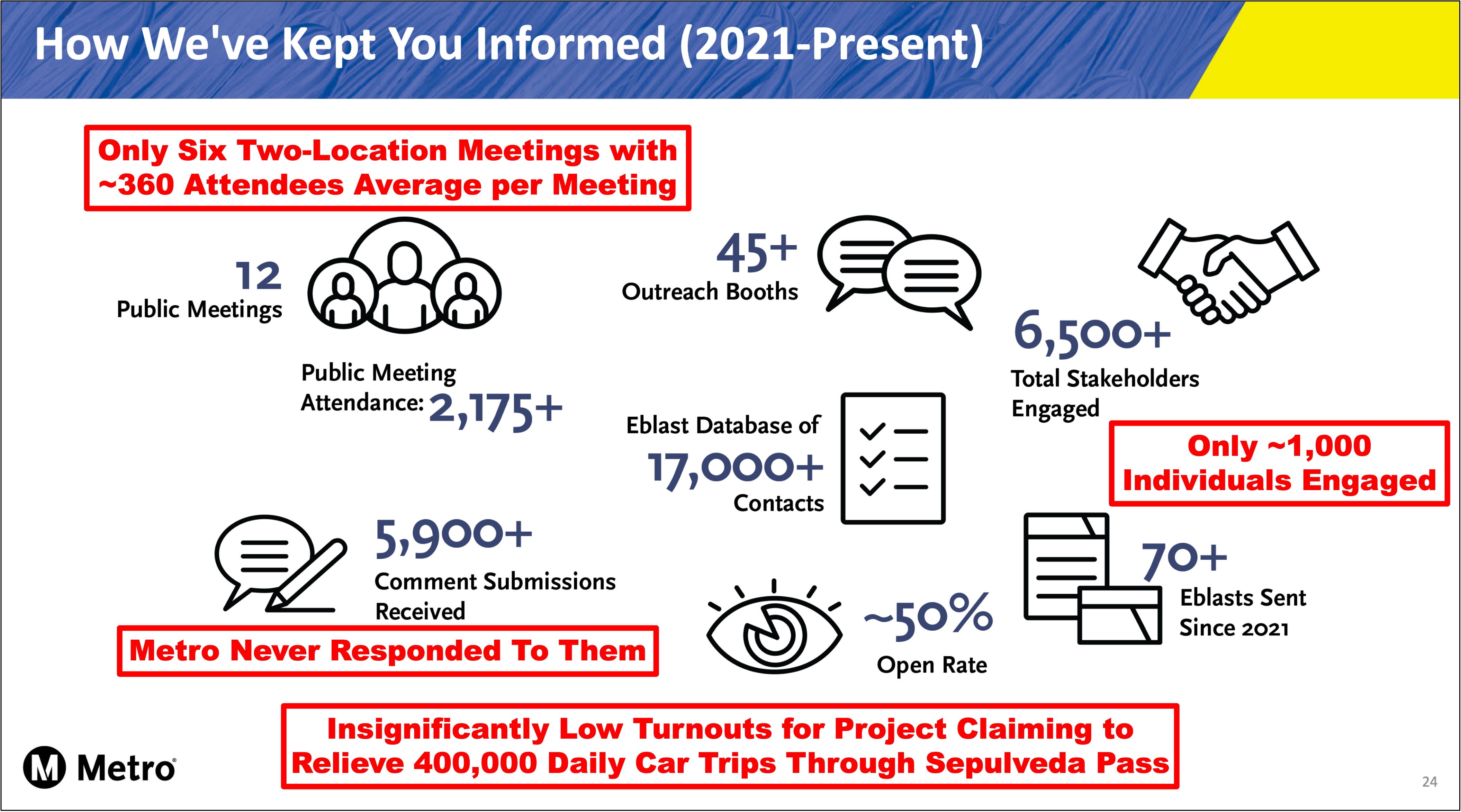Comments
LA TRANSPO - This is the fourteenth article in a series examining whether Metro can be a trusted steward for the Sepulveda Pass Transit project.
LA TRANSPO - The eighth of my 20 questions to Metro CEO Stephanie Wiggins asked: “What actions did Metro employ to implement its ‘partnership with the public’ that former Metro CEO Phil Washington promised in his December 2016 letter? In his heartfelt letter after voters passed Measure M, Phil Washington stated: ‘We look forward to our continued partnership as we move forward to deliver Measure M to the people of LA County. We are committed to keeping you updated and engaged in our progress as we implement this world-class program.’ Looking back today, it seems like Metro never tried to realize such a partnership and certainly never implemented it. This further detracts from Metro as a trusted steward.”
Metro’s long-winded answer focused solely on the quantity of outreach they’ve done and completely ignored the quality of their outreach: “Metro has continued – and expanded – its partnership with the community since the passage of Measure M. This includes the nationally recognized Community-Based Organization Strategy (CBO), Metro Youth Council, and Countywide Faith Leaders Program, among others. Metro has expanded and refined its Project Labor Agreements, Construction Careers Program, and commitments to contracting with small businesses. Since the passage of Measure M and the Feasibility Study for the Sepulveda Transit Corridor project, Metro has steadfastly focused on executing an outreach program that provides a wide range of opportunities for engagement. Given the regional importance of this project, the outreach has been focused not only within the study area but also in the surrounding communities from which trips through the corridor originate, particularly in the northern San Fernando Valley. To that end, the team has held multiple, bilingual (English and Spanish) forums for community engagement. Metro has hosted 22 public meetings, engaged with more than 12,000 stakeholders, and gathered more than 7,000 comments. Copies of the meeting presentations, materials, and recordings of the virtual community meetings are posted on Metro’s website. The team also recognized that many people are not able to participate in public meetings or feel comfortable doing so. Therefore, they have also engaged the public at events/festivals, stakeholder briefings/meetings, transit stations, churches, and youth events. All this public engagement has been and will continue to be shared on the project website. An outreach summary will also be included as part of the Draft EIR.”
Both high quantity and high quality are mandatory for successful public outreach. This article focuses on the low quantity of Metro’s outreach; next weeks will focus on the poor quality.
At its most recent May 2024 public meetings, Metro presented the chart below, again focused solely on the quantity of its outreach, not the quality. The numbers are insignificantly low for a project of this importance, size, and complexity. The 2,175 attendees at 12 public meetings averages only 360 per meeting because there were only six meetings, each having two locations. Many people attend every meeting, so the total individual people attending all meetings is only about 1,000. And 1,000 attendees are a drop in the bucket for a project to relieve traffic on the 405 freeway – with 400,000 trips through the Pass each weekday and Metro estimating up to 120,000 passenger boardings for the project every day.

Metro should have had 10,000 individual attendees after four years of meetings – if their outreach proved worthy to the public. Instead, Metro’s latest May 2024 Valley meeting had only about 40 attendees. Some attendees complain about Metro’s “dog and pony show” meetings with little information. Just as Metro never responded to the 5,900+ comments they received, they try to engage the public with trivial information – and are failing.
Metro’s grade for the quantity of its public outreach is at best a D-plus. This is a high grade compared to the one next week’s article will give the quality of their public outreach. It’s no wonder that Metro’s promised Partnership with the Public never materialized.
(Bob Anderson is a nuclear engineer with 50 years engineering and business development expertise in the aerospace and high-technology sectors. He is VP and Transportation Committee Chair of the Sherman Oaks Homeowners Association. Contact him at [email protected].)
















